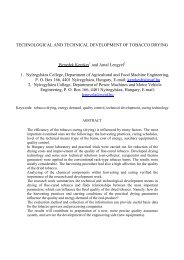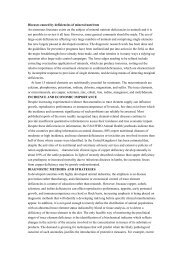第二章昆虫的生物学特征
第二章昆虫的生物学特征
第二章昆虫的生物学特征
Create successful ePaper yourself
Turn your PDF publications into a flip-book with our unique Google optimized e-Paper software.
第二章<br />
生物学特性<br />
Chapter2 Biological Characteristic<br />
• 一,本章重点是基本概念和名词:<br />
• 1.两性生殖sexual reproduction<br />
• 2.孤雌生殖parthenogenesis<br />
• 3.幼体生殖paedogenesis<br />
• 4.多胚生殖polyembryony<br />
• 5.变态metamorphosis<br />
• 6.龄期stadium or instar<br />
• 7.羽化emergence<br />
• 8.补充营养supply nourishment<br />
• 9.多型现象polymorphism<br />
• 10.世代,世代重叠generation overlapping<br />
• 11.休眠dormancy,滞育diapause<br />
• 12.日出性diurnal insect和夜出性昆虫nocturnal insect<br />
• 13.趋性taxis,迁飞flying<br />
• 14.变态类型,卵的类型,根据刺激源可将趋性分为什么?
第二章<br />
生物学特性<br />
Chapter2 Biological Characteristic<br />
• 二. 昆虫的生长与发育<br />
• The Growth and Development of Insects<br />
• Eggs: Insect eggs differ in shape and color, and some are<br />
ornamented with ridges, spines, or other processes. Most<br />
insects lay their eggs in a situation where the young on<br />
hatching will have conditions suitable for development. Many<br />
lay their eggs in characteristic masses, and a few cover their<br />
eggs with a protective material of some sort. The eggs of some<br />
insects develop internally, and the young are born alive.<br />
• Growth: The Growth of an insect is accompanied by a series of<br />
molts, in which the exoskeleton (outer shell) is shed and<br />
renewed. Insects change in form as they grow, and the amount<br />
and character of this differ from group to group. This change is<br />
called metamorphosis(变态).
第四章<br />
昆虫发生与环境的关系
第二章<br />
生物学特性<br />
Chapter2 Biological Characteristic<br />
• 二. 昆虫的生长与发育(egg larva pupa adult)<br />
• The Growth and Development of Insects<br />
• 变态(metamorphosis): Successive instars differ not only in size but in other features<br />
as well. This change during growth (metamorphosis) is relatively slight in some insects,<br />
very marked in others. There are 2 principal types of metamorphosis---simple and<br />
complete.<br />
•<br />
• Simple metamorphosis: In this type the wing develop externally during the<br />
early instars, compound eyes are present in the early instars if they are present<br />
in the adult, and there is no prolonged resting stage before the last molt. The<br />
immature instars of insects with this type of metamorphosis are called nymphs.<br />
• Complete metamorphosis: The eggs of insects with complete metamorphosis<br />
hatch into a wormlike stage called a larva. The larvae of insects vary in<br />
appearance: some have legs and others are legless and some lack a well-<br />
developed head. Larvae do not have compound eyes(but may have ocelli), and<br />
if the adult is winged the wing begin their development in the larval stage but<br />
develop internally. The larval stage lasts from a few to several instars,<br />
increasing in size and sometimes changing in color or other characters. After<br />
the molt of the last larval instar the insect changes to what is called a pupa.<br />
Pupae are usually inactive. They do not feed, and are sometimes enclosed in a<br />
protective covering, which may be a conoon formed by the last larval instar<br />
before it molted or may be a puparium (formed of larval exoskeleton).
三<br />
昆虫的生活史(Life history)<br />
• Life history: most insects in our area have a single generation a<br />
year. The adults are present for a limited time during some part<br />
of the year, and the winter is passed in a dormant state. Insects<br />
overwinter in different stages– some as eggs, some as nymphs,<br />
some as larvae, some as pupae, and some as adults. A period of<br />
dormancy at low temperature is often an essential feature of the<br />
life cycle. Many insects will not complete their development<br />
unless exposed to low temperature.<br />
• Generation: Some insects regularly have 2 generation a year and<br />
others may have several—continuing to reproduce as long as<br />
weather conditions are favorable. A few require more than a year<br />
to complete their development. Many of the larger insects in<br />
northern areas take 2 or 3 years; the record holders are some of<br />
the periodical cicadas(蝉), which take 17 years.<br />
• 成虫(adult): Adults of most insects live only a short time,<br />
ordinarily from a few days to a few weeks. An overwintering adult<br />
lives several months, and the queens of some socil insects can<br />
live several years. Many insects that are shot-lived as adults do<br />
not feed in the adult stage.
第四章<br />
昆虫发生与环境的关系
粉纹夜蛾<br />
Trichoplusia ni<br />
Cabbage looper<br />
Eggs Larvae
斜纹夜蛾<br />
Spodoptera<br />
litura (F.)<br />
Common Leafworm Adult<br />
1.It is a totally polyphagous pest and feed on a very wide range of crops including vegetables, cotton, rice, tomato and tobacco. Other host<br />
plants include Citrus, cacao, sweet potato, rubber legumes, sorghum, maize etc.<br />
2.Distribution:It mainly distributes in South and Eastern Old World tropics, including Pakistan, India, Bangladesh, Sri Lanka, China,<br />
Korea, Japan, Thailand, Vietnam, Philippines, Indonesia, Austral-Asia, Pacific islands, Hawaii and Fiji.<br />
3.Damage:This caterpillar is basically a leaf-eater. Heavy infestations can seriously defoliate the crops, especially the young plants.<br />
• Newly hatched larvae are gregarious and remain together and skeletonize the leaf on which they feed. Later they disperse and<br />
become more solitary and nocturnal in habits. One generation can be completed in as little as 24-30 days, and in the humid tropics<br />
there may be 8 generations annually.<br />
4. Identification:<br />
• Adult : The adults are pale brownish moth, with the yellow-brown forewing having a distinctive pale band medially: wingspan is 30-40 mm.<br />
• Eggs:Eggs are spherical (0.3 mm) in diameter, and laid on the undersides of leaves in batches of 100-300 and<br />
covered with yellow colored hair-scales.Each female lays about 100-2000 eggs, hatching requires 2-6 days.<br />
• Larvae:The newly hatched larvae are pale green at first, and with a distinct black band on the first abdominal segment. Later they<br />
become brown with dark marking, with yellow lateral and dorsal stripes.The lateral yellow strip is bordered dorsally with a series<br />
of semi-lunar marks.<br />
• Pupa :Pupation takes place in the soil in an earthen cell, just beneath the surface, The pupa is dark red, 15 -20 mm long.<br />
Eggs Larvae
小菜蛾 Plutella xylostella (L.)<br />
Diamondback moth
蔬菜蚜虫<br />
Vegetable aphids<br />
1 萝卜蚜<br />
Lipaphis erysimi<br />
Turnip Aphid<br />
2 桃蚜<br />
Myzus pericae<br />
Green Peach Aphid<br />
3 甘蓝蚜<br />
Brevicoryne brassicae<br />
Cabbage Aphid<br />
1. Cabbage aphid and turnip aphid mainly feed on<br />
cruciferae. Cabbage aphid prefers cabbage and<br />
other Brassica spp but turnip aphid likes Chinese<br />
cabbage and radish better. Green peach aphid is<br />
truly a polyphagous species; about 875 plants in 35<br />
different families are recorded as its hosts. The<br />
main host is peach, the alternative hosts include<br />
potato, tomato, tobacco, beet, cereals and<br />
vegetables. All three species of aphids occur<br />
commonly and mixed on cruciferous vegetables in<br />
China.<br />
2.Distribution<br />
• Cabbage aphid: The aphid distributes throughout<br />
Turnip Aphid<br />
the world in temperate and subtropical climates.<br />
•<br />
In China it occurs nearly all parts of the country<br />
besides Tibet .<br />
Turnip aphid: Mostly in temperate and subtropics<br />
regions. In China it is dominate species in<br />
Xinjiang autonomic distract.<br />
• Green aphid: A completely cosmopolitan species<br />
with a worldwide distribution.<br />
• All species of the aphids occur year around in<br />
South China. No eggs are found in the host plants<br />
during the winter. All stages of the pests can be<br />
found on the vegetable crops in winter season.<br />
They reproduce by parthenogenesis. The<br />
population increases very rapidly under favorite<br />
conditions.<br />
3.Damage:<br />
Green Peach Aphid<br />
• Cabbage aphid: The aphid attacks many crucifers,<br />
especially cabbage, cauliflower. It is known to<br />
transmit a number of virus diseases in the host<br />
plants. Nymphs and adults suck plant sap, causing<br />
distortion, stunting. curling, wilting and often lead<br />
to death of these host plants when severely attack<br />
happened.<br />
4. Identification<br />
• Turnip Aphid: Turnip aphid is similar to the<br />
cabbage aphid in appearance, but has a more<br />
distinct green to yellow-green yellow green color with less<br />
noticeable powdery wax on the body, and it lacks<br />
the dark transverse marks on abdomen.<br />
• Green Peach Aphid: Green peach aphid is rather<br />
slender in form, light green or yellow, with<br />
•<br />
indefinitely darker stripes on the abdomen. abdomen<br />
Cabbage Aphid: Cabbage aphid is grayish-green grayish green in<br />
Cabbage color and the body is covered Aphid<br />
with a fine powdery<br />
wax, which gives heavily infested plants a whitish<br />
appearance.
甜菜夜蛾<br />
Spodoptera exigua<br />
Beet Armyworm<br />
Adult<br />
1.It attacks more than 170 different species of host plants including cabbage, radish, lettuce, eggplant, pepper,<br />
tomatoes, potatoes, beans gourds, rice, cotton, sugar beet, tobacco, etc.<br />
2.Distribution:Africa, Southeast Asia, Central and South Europe, Middle East, Australia, Southern USA, India,<br />
Southern China, Philippines, Indonesia, and Canada.<br />
3.Damage:Young larvae eat foliage within webs underside of the leaves. The caterpillars are gregarious, moving in<br />
swarms, and destroying the young leaves and stems of the host plants. Young seedlings can be completely<br />
destroyed, but older plants often recover after an attack and may be still vigorously. Young larvae skeletonize<br />
the underside of the leaves, but later as they grow they eat the entire lamina. In South China there are usually<br />
eight generations.<br />
4. Identification:<br />
• Adult:The adult is a small brown moth of wingspan up to 25 mm, and the fore wing is grayish-brown with two<br />
yellow spots near the center. The hind wing is a translucent white with narrow brown borders, There are<br />
rather nondescript in appearance and not easy to recognize.<br />
• Eggs:Eggs are laid on the leaves of the host plants, in clusters, several layers thick, and covered with hairs from<br />
the female abdomen. Each cluster contains 50-300 eggs, one female can lay 300-900 eggs (up to 1700). Eggs<br />
usually hatch after 2-4 days.<br />
• Larvae:The larvae are very gregarious, at first green, later becoming variable green or brown usually with a<br />
lateral strip. Young larvae Eggs skeletonize the underside of the leaves, Larvae<br />
but as they grow they eat the entire<br />
lamina.Pupa: Pupa:Pupation takes place in the soil and lasts about 6 days.
Homework<br />
Chapter2 Biological Characteristic<br />
• 一,本章重点是基本概念和名词:<br />
• 1.两性生殖sexual reproduction<br />
• 2.孤雌生殖parthenogenesis<br />
• 3.幼体生殖paedogenesis<br />
• 4.多胚生殖polyembryony<br />
• 5.变态metamorphosis<br />
• 6.龄期stadium or instar<br />
• 7.羽化emergence<br />
• 8.补充营养supply nourishment<br />
• 9.多型现象polymorphism<br />
• 10.世代,世代重叠generation overlapping<br />
• 11.休眠dormancy,滞育diapause<br />
• 12.日出性diurnal insect和夜出性昆虫nocturnal insect<br />
• 13.趋性taxis,迁飞flying,假死性feign death?<br />
• 14.变态类型,卵的类型,足的类型,蛹的类型?<br />
• 15.根据刺激源可将趋性分为什么?<br />
• 16. .螨类与昆虫的区别?
测验题(三)(20分钟)<br />
• 1.两性生殖?<br />
• 2.孤雌生殖?<br />
• 3. 多胚生殖?<br />
• 4.变态?<br />
• 5.龄期?<br />
• 6.羽化?<br />
• 7.补充营养?<br />
• 8.休眠和滞育有什么区别?<br />
• 9.趋性?根据刺激源可将趋性分为 什么?<br />
• 10. 螨类与昆虫的区别















